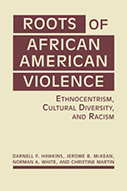ROOTS OF AFRICAN AMERICAN VIOLENCE: ETHNOCENTRISM, CULTURAL DIVERSITY, AND RACISM

Authors: Darnell F. Hawkins, Jerome B. McKean, Norman A. White, and Christine Martin
Publisher: Boulder, CO: Lynne Rienner Publishing, 2017. 267p.
Reviewer: James Unnever | October 2017
One of the most contentious issues confronting criminology is the relationship between race and crime. The authors here have to be applauded for tackling this most explosive issue. As Hawkins et al. point out, criminologists have not had the theoretical tools to meaningfully discuss this issue and they have been handcuffed by the fear of being accused of “blaming the victim.” That is, being accused of arguing that blacks commit crimes as a result of having some kind of character defect. Thus, it is a welcoming breath of fresh air to read a theoretically-grounded treatise that tackles the thorny issue of race and crime.
Notably, Hawkins, et al. reject the thesis that criminology has to develop a Black Criminology in order to fully understand why blacks commit crime (Unnever and Gabbidon 2011). The authors do not incorporate into their theoretical framework the research that shows that the everyday experiences of being black in a systematically racist society are reasons for black offending (Unnever 2014; Unnever, Cullen, and Barnes 2016; Unnever, Cullen, and Barnes 2016a).
Instead, Hawkins, et al. propose a general theory of crime. More specifically, the authors present a racially invariant general theory that purports to explain the causes of homicide. Their endorsement of the racial invariance thesis dictates that their theory argues that blacks and whites commit homicide for similar reasons.
As the authors acknowledge, much of their theory is derived from the tenets of another general theory of crime — social disorganization theory. Both theories argue that the fundamental cause of crime arises from the structural conditions in which people live. That is, place matters. Hawkins, et al. add that while the dynamics of places change over time, these changes do not diminish the salience of place as the etiological origin of crime.
Similar to social disorganization theory, Hawkins, et al. argue that institutionalized racism is related to black offending principally by its impact on the formation of inner-city ghettos populated mostly by blacks. The authors also highlight the crucial role that racialized social control policies have had in creating hyper-segregated black communities. These institutionalized racist practices have caused blacks to experience an ethnic spatial compression that defines the social and physical boundaries of black communities in urban America. Whites, on the other hand, have been much more unrestricted in their ability to move away from one another and, therefore, they have not experienced as much ethnic spatial compression and hyper-segregation.
Broadly, the ecological general theory of crime highlighted here begins with the assumption that there is wide ranging cultural diversity among whites and blacks who live in mostly segregated and differentiated places. This historically consistent cultural diversity manifests itself with individuals having hidden and explicit within race group identities. Hawkins, et al. propose that within race group identities generate an affinitive ethnocentrism. Affinitive ethnocentrism involves boundary setting efforts that define, maintain, and defend a group’s identity.
The cultural diversity within the black community arises from multiple factors, including skin tone, socioeconomic status, ethnicity (e.g., foreign born blacks), and place of origin (e.g. the south). The cultural diversity within the white community primarily arises from the individuals’ ethnic affiliation (e.g., Polish, Irish, Italian, etc.). These place-based group boundaries serve as markers for within race intergroup interactions in both black and white America.
Intra-racial interpersonal conflict is the result of competitory ethnocentric allegiances—conflictive ethnocentrism—between race specific groups who reside in the same areas. This crime producing inter-group conflictual process unfolds similarly for both whites and blacks. However, the higher rates of crime found within black urban communities are caused by the effects of ethnic compression and hyper-segregation, coupled with greater economic deprivation. The combination of these deleterious structural conditions heighten the likelihood that individuals will react to perceived group based transgressions with higher levels of interpersonal aggression. Thus, areas that are spatially confining and culturally diverse produce a “pressure-cooker effect,” and one of the outcomes is homicides. Notably, Hawkins, et al. hypothesize that if whites were economically constrained and had to live in ethnically diverse neighborhoods that are spatially compressed and economically disadvantaged, their rates of homicide would be comparable to those of blacks.
In summary, Hawkins, et al. hypothesize that unlike whites, blacks have less freedom to move. This hyper-segregation fosters economic deprivation, ethnic compression, and within race group conflicts, which collectively produce high rates of homicide. The lower rates of homicide for whites occur as a result of their greater freedom to move, which lessens their exposure to within race group conflicts and concentrated economic deprivation.
As the authors continue to revise their theory, they may wish to consider the following suggestions. A core tenet of this theory is that within race group based conflict is related to high rates of homicide. For example, Hawkins, et al. argue that one source of within place black group identity is their place of origin (e.g., the Deep South versus elsewhere). However, the authors provide no empirical evidence that blacks ground their identity in their place of origin (or their current place of residence). The authors also do not provide any empirical evidence that this hypothesized component of their racial identity causes conflict among blacks. This omission becomes particularly problematic given that the majority of homicides are committed by people who are somewhat intimate with one another. Thus, it is not clear why conflict would arise between individuals who intimately know one another based on their place of origin. Likewise, the authors provide no evidence that homicides within white communities largely reflect within race group conflicts. If this is the case, data supporting their theory would presumably show that offenders should mostly have a different ethnicity than their victims. Perhaps intra-group conflict among black and white youths is related to their current place of residence and this conflict generates more impersonal homicides. This hypothesis would be consistent with inter-gang violence based on “turf” related issues. There is ample evidence that supports this contention.
In conclusion, it is unclear why the title of their book is, Roots of African American Violence: Ethnocentrism, Cultural Diversity, and Racism. With their endorsement of the racial invariance thesis, a more appropriate title would seem to be, “Roots of Interpersonal Violence: A General Theory of Homicide among Blacks and Whites.”
James Unnever USFSM, Professor of Criminology
References
Unnever, J. D. (2014). A Theory of African American Offending: A Test of Core Propositions. Race and Justice 4(2): 98-123.
Unnever, J. D., Francis T. Cullen, and J.C. Barnes (2016). Racial Discrimination, Weakened School Bonds, and Problematic Behaviors. Journal of Research in Crime and Delinquency 53(2): 139-164.
Unnever, J. D., Francis T. Cullen, and J.C. Barnes. (2016a). Racial Discrimination and Pathways to Delinquency. Race and Justice, Published online.


